Hello everyone and welcome back to another Friday full of new products. Let me start by saying that shipments are starting to show up. We had a dry past few weeks, but we're starting to receive all the stuff we ordered over summer. Expect the next few weeks to be loaded with goodies. We've got some exciting new stuff on the way, in addition to what we have today. It's been busy, but I'll try my best to demo and show as much as I can.
Vimeo version found here
Hey, how about that fancy new intro, eh? Hopefully showing all the little connectors and switches and such on video gives you all a better idea of how big they are and how to use them. Sometimes pictures just aren't enough. We will be getting datasheets on all of them soon enough, so stay tuned. Our supplier is on vacation, so we're just waiting for them to get back and we'll get the datasheets up on all the product pages.
This week we've got a new robotics kit from the fine folks over at Parallax. This heart of this kit is their Board of Education Shield, which is a prototyping board for Arduino that attaches to the metal chassis. The ambulation occurs with the aid of two continuous servo motors and wheels. It comes with all the hardware you need to put it together as well as a pack of electronic bits to start playing around. Their website also has a lot of resources available for educators to teach various lessons with the whole setup.
Speaking of Parallax, our own education team is going to be doing a LilyPad class at Parallax later this month. It's our first collaborative effort with them so if you're in the area (California) and want to take a class at Parallax, this is your chance. Go here for more information.
The power supply is oftentimes the last thing I design for a project, so testing it 'out in the field' consists of using it in my car, since it conveniently has a 12V power source. This 12V car adapter lets you make an easy power supply by just soldering on some wires. Taken it apart, solder in some wires, put it back together, and you have your very own way to get 12V out of your car battery. It even has an LED to indicate power.
We see a lot of books here and we turn down quite a few. Not every book makes the cut. This robotics book caught my eye because it took a much different approach to robotics. Instead of getting into the technical details, it starts at a much more basic level and incorporates fun projects you can do at home with minimal materials. Not all projects have to include hundreds of dollars of parts and hours of code! The book is primarily aimed at a younger audience, but I found it pretty enjoyable because of the amount of information it was able to cover in a relatively small space. It's worth checking out and would make a great gift for someone looking to just tinker around with stuff.
A lot of people like our small key switch, but for those of you wanting something a bit bigger and beefier, check out this new key switch. It's a little bigger, sturdier, and has a threaded barrel instead of just snapping in.
This simple barrel jack plug is great for making your own cable. Solder on some wires, crimp the strain relief and screw on the outer shell and you have a nice custom cable. It works with all the standard barrel jacks we sell (5mm, 2.1mm diameter).
Need to connect a few more pins? This 6-pin chassis connector set includes both the male and female bits and has a locking ring so it won't pull out of your panel. The panel-mount part screws into your panel while the mating plug locks into place with a threaded ring to make a secure connection. The connector even has a strain-relief clamp for those thicker cables.
This simple inline switch is what you might find on a lamp. How many times have you wanted a simple on/off switch but didn't want to have exposed wires? This inline switch neatly tucks all the wires away in its enclosure and gives you a nice clicky on/off switch for power.
We have a new version of the MaKey MaKey Standard kit this week. We are now including a set of basic jumper wires with the standard kit. Everything else is the same (except for some minor firmware tweaks). Get on the MaKey MaKey bandwagon and start finding things to replace your keyboard and mouse!
That's it for this week. My desk is over-flowing with new stuff for next week. Our photographer just got back from Maker Faire and he's got a mountain of new stuff to photograph for the site. Check back next week for more new goodies. Thanks for reading and watching and we'll see you next week!
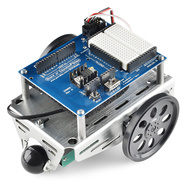
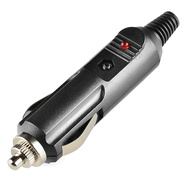

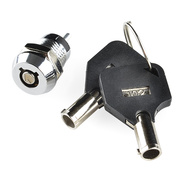

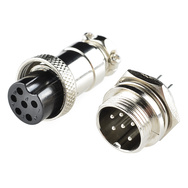
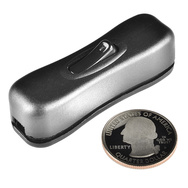
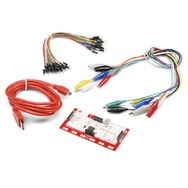
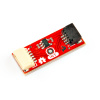
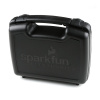
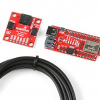







These 'continuous servos' are positional servos hacked to have their feedback loop disconnected, and their mechanical limiters removed. They are definitely not very accurate; maybe not as accurate as a decent DC motor and controller pair, certainly not as accurate as a closed loop system with a motion encoder.
For a but more background, we need to look at the original purpose of these servos. the unhacked servos are designed to move towards a specified position with a speed that is proportionate to how far away they are from that position at the moment, slowing and stopping as they arrive at the specified position.
The position is communicated as a pulse width signal that encodes a reference voltage which is compared against the value of a small voltage divider/potentiometer inside the servo. The shaft of this potentiometer is directly connected to the output shaft of the servo. The diference in voltage/position between the signal and the actual potentiometer voltage/position is translated by analog circuitry into the driving voltage for a small motor in the servo.
Now how the hack works. By setting (mechanically) the potentiometer to the middle of its operating range, and then disconnecting its linkage to the output shaft any signal sent to the servo above or below this center voltage (again, usually expressed as a pulse width) will cause it to move, continuously, in the direction that would bring those signals into agreement, like the proverbial donkey and dangling carrot. Assuming mechanical restrictions to movement have also been removed we now have a continuous motor, that even allows some degree of speed control, by how far away from center the signal voltage is.
What does this have to do with accuracy? Well analog servos are only so accurate to begin with, if they are calibrated right, assuming that the potentiometer is consistent through its range of operation. Two servos rarely share the same center voltage, but calibration yields a linear scale that translates to position for each servo fairly reliably.
Speed however is a function of the differences between the desired location, and the set center voltage on a hacked servo, and while position is reached by an iterative loop of slowing to a stop, the speed of a continuous servo is only controlled by the first estimate of how fast the servo needs to travel to start making up the difference. That is to say not a lot of engineering is needed for figuring out how fast a given servo should move at any point in time, because even a rough approximation yields good results -- at least concerning postion.
So when cleverly hacking the very clever analog servo, the best we can hope for is a reasonably approximate speed control, with explicitly no feedback loop. This makes these 'continuous servos' terrible for dead reckoning the postion or velocity of a robot, but it makes them perfect for inexpensive robotics projects, assuming the robot is continuously observing and correcting its own behavior ( a good example is a line following robot, following the line serves as its own feed back loop).
Make sense?
( note, if a company is manufacturing continuous rotation servos, they may be using a fixed reference value, like a resistor as a voltage divider instead of a potentiometer, but this only adresses one of the issues, and then only so much as those resistors and/or other circuitry are consistent )
Adam: Thanks for your detailed comments. Very helpful.
Glad it was useful, I feared I may have gotten a bit carried away.
Hi, I was wondering if you saw the new Freescale Freedom development platform, and if you do... are you planning to sell this? It is well compatible with much of the Arduino boards (I would think all of them but I'm not sure) and well, you know, a 32 bits Microcontroller with full speed USB and an accelerometer, a touch pad and that costs 13 dollars I think is very attractive. I would love to see this board working with your awesome Arduino boards.
http://www.freescale.com/webapp/sps/site/prod_summary.jsp?code=FRDM-KL25Z
any chance we could see some 2n2222 transistors available as its own product?
The 2N3904 can switch less current, but otherwise is very similar to the 2N2222.
i need the higher current switching ability.... any other suggestions for switching 200+ mA?
Why is te robotics kit so expensive? It is very well made by the look of it though.
Not sure its showing all the parts. On the Paralax they show a ton of sensors. I think this tutorial is also for this kit.
http://learn.parallax.com/ShieldRobot
The video is 11:55. The intro is 00:08.
In terms of branding, it shows SF's evolving polish.
The only downside is for Rob (or the intro's producer). Should Rob shave, age, experience a weight change or is replaced, the intro will be out of date.
No worries. The national television networks deal with this all the time.
Clean, distinct...branded.
Keep it.
Thanks! Glad you like it! In all honesty we didn't put this much thought into it. One of our designers, Nic, is becoming quite the motion graphics wiz, and we thought it would be fun to give each of the regular video segments a little flair. Wait til you see the new According to Pete intro on the 15th!
BOE (Board of Education) this is just a learning platform. The continuous rotation servos are a low cost drive for this platform with out any type of position feedback. Motion encoders would be one of the next upgrades for continued learning.
There are two types of non-shield BOE boards, the BASIC Stamp controller board or a Propeller controller board. Of these boards the ground level would be the BASIC stamp, Mid level would be the Arduino and highest level Propeller. The Basic Stamp & Arduino are single core, the Propeller is an 8 core micro-controller.
Robert, how in the heck did you go from Psychology to Electronics Expert? Please share.
It's all just an elaborate magic trick.
The 6-pin chasis conector was mainly used as main conector of amateur radios microphone and this is pretty strong conector (http://www.k-po.com/data/shop/preview/b420x420/30072.jpg). I give me good memories of that time :)
I agree with icyfye: Robert, your beard is so cool this week!
haha, thanks :-) it's coming along nicely. my wife has removed all shaving or trimming tools from the house.
They don't let me have sharp objects either.
It's awesome that there is so much stuff this week.
-
I don't know how I feel about the new intro. I like the fact that it's cool, and I suppose that if I were a brand new customer I would be completely neutral about it. I guess I'm just accustomed to the old intro, and opposing change. Was there a specific impetus that evoked this new intro? It seems like the first few minutes/products in this post were geared toward people who were completely new to electronics/SparkFun, or perhaps investors of some sort. It was kind of off-putting.
-
Your beard looks exceptionally thick this week.
-
Thanks for the post!
Good points. Honestly, I don't really 'aim' my posts towards anyone in particular. With the switches and buttons and such, even the most seasoned engineer will want to know what they look like and how they are in person, rather than just a picture. It's more for everyone, than beginners.
The intro is just something we're doing since we have an intro for the engineering round-table and the according to Pete videos. The new product post videos are our oldest and most frequent, so why not get a proper intro on it?
We might also change up the venue next year too. Change is good, after you get used to it ;-)